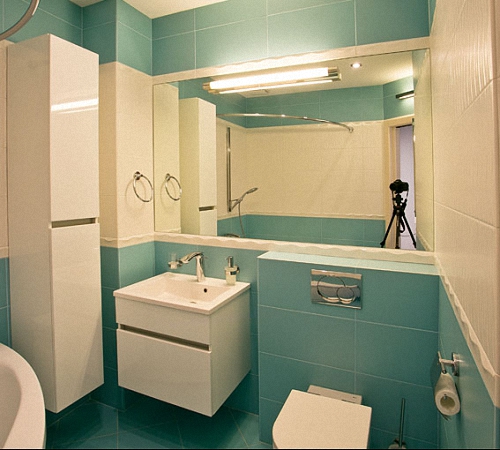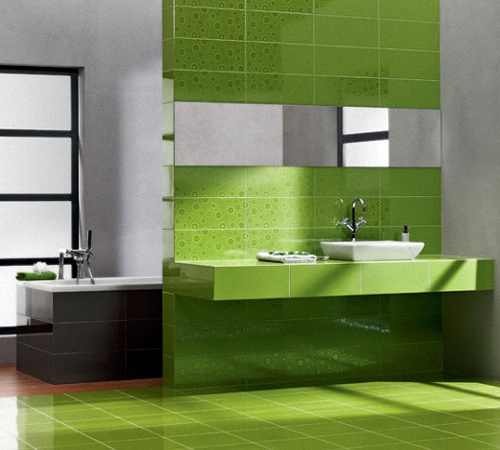Breeding - a popular material in the roof decoration. But, so that the roof is from ...
|
|
Wallpaper is one of the most popular types of walls. The coating is different ... |
One of the most ancient building structures arch does not lose its ... |
Calculation of ceramic tiles: features and examples

The laying of ceramic tiles is preceded by the procedure for its calculation. It is the correctly conducted calculations that are the key to lightness and simplicity in carrying out the installation of tiles. At the same time, it is important to accurately calculate the amount of tile itself, but also the necessary materials for its grout and gluing to the surface. We will consider how to calculate ceramic tiles about how to conduct a calculation of ceramic tiles.
Table of contents:
- Ceramic tiles - features and advantages
- Functional purpose and varieties of ceramic tiles
- Features of calculation of ceramic tiles
- Tile diagonal calculation and features of its implementation
- Tile calculation technology
- Calculation of tiles for apron
- Features of the calculation of paving slabs
Ceramic tiles - features and advantages
Ceramic tiles are called finishing material, which is based on clay and sand processed in a special way. Ceramic tiles are natural material, which is absolutely safe and harmless to human health.

We offer to get acquainted with the main advantages of ceramic tiles:
1. harmlessness, non -toxicity.
All toxic substances that are present in the material for the manufacture of tiles are removed from it during firing. In addition, when firing from tiles, any substances that can cause allergies are also removed. Therefore, this material is suitable for decorating premises of any type and purpose.
2. Biological inertia.
This property prevents the risk of developing fungus on the surface of tiles and various kinds of microorganisms. Therefore, this tile is common in the process of finishing work in laboratories or sanatorium-resort institutions.
3. Moisture resistance and dirt.
Even the abundant effects of water on ceramic tiles are not able to change its properties. This characteristic allows you to finish with tiles kitchen surfaces, pools, baths and other places that are exposed to increased moisture.

4. Stability before pollution and ease of washing.
The true layer of tiles covers a certain glaze that does not allow accumulation of fat or dirt on it. In addition, this coating increases the resistance of the tile in front of chemical abrasive substances. In addition, the tiles are easy to care for, and therefore, its use is recommended in places subject to pollution. Dirt and dust are not collected on the tile, which often cause allergies.
5. Duration of operation.
With the correct selection of tiles for its intended purpose and properties, it will serve its owner for more than a dozen years. Subject to tile laying technology, it will not need care for a long time.
6. Stability before abrasion.
Tiles are resistant to scratches, furniture easily moves along it. Ceramic tiles are a great option for rooms with intensive movement.

7. High mechanical strength.
Ceramic tiles are suitable for arranging not only residential premises, but even garages. Due to its strength, it is able to withstand the weight of the car.
8. Stability before fire and fire safety.
This tile is not susceptible to combustion, in case of fire, it cannot spread fire.
9. Light resistance.
The drawing or texture that was applied to ceramic tiles in the process of its manufacture remains the same in the process of the entire period of its operation. Therefore, tiles are also used to arrange terraces, stairs and other elements that are under the influence of direct sunlight.
10. An attractive appearance.
The surface of the tiles is decorated with any drawings, patterns, paintings and even photos. Thanks to this, this finishing material will easily fit into any type of interior.
Functional purpose and varieties of ceramic tiles
Among the functional features of ceramic tiles should be distinguished:
- Excessive level of fragility - although ceramic tiles are able to withstand even the car, with a strong blow to it, some kind of heavy object, it can crack;
- Not elasticity - ceramic tiles are able to cover exclusively perfect surfaces, it is not able to bend or change shape;
- The need for professional styling skills - in the absence of tiles, its installation is not possible.

Among the wide variety of ceramic tiles, we propose to highlight several of its varieties:
1. Tiles of the majolica - has an opaque glaze, for its manufacture a pressing method is used. This version of the tile is subjected to double firing, due to which its moisture resistance, strength, resistance to acids and alkalis improves.
2. Ceramic tiles, called a cerral - is also exposed to double firing. But, in its manufacture, it requires a more expensive raw material, in the types of sand, clay and flux. This type of tile is in white, so the pattern on it manifests itself very well. Such tiles are used in the process of interior decoration.
3. Another variety of ceramic tiles of an unglazed nature is Cotto. It is made from a special variety of clay mined in America or in the Mediterranean Sea. The tile has the highest mechanical strength, so it is great for flooring. It goes well with ethnic interiors, since in appearance it has uneven edges and orange.
4. The use of porcelain tile is associated with floors that have a high level of operational effects. This tile is obtained thanks to the pressing of kaolin clay with sand and quartz. In terms of hardness, it is compared with granite. The tiles are very stable before abrasion, it is not capable of changing color, has a minimum level of moisture absorption, stable in front of chemicals and frost. It is used both outside and indoors, mainly for flooring.
5. The last option is clinker tiles, is a ceramic tile made on the basis of natural clay. This material has the highest hardness. In addition, clinker tiles have high mechanical strength, it is resistant to abrasion and chemical effects. Thanks to this, it has a wide range of application.

Features of calculation of ceramic tiles
Conducting a calculation of tiles is a rather complicated process that requires special attentiveness. In order to purchase the right amount of tiles, you should initially correctly calculate the area of \u200b\u200bthe site that will be trimmed with it.
The opinion that if the tiles are not enough, then it can be purchased more is absolutely wrong. Since it is better to purchase tiles from one batch, otherwise, it can differ in color, shade or texture.
In addition, most often, the tiles are mistaken when calculating the area of \u200b\u200bthe walls. Incorrectly calculated quadrature leads to errors in determining the required amount of tile. This is especially important when buying expensive materials.
Calculation of the number of tiles, a purely individual procedure that directly depends on the individual characteristics of the room, on the size of the tile and the method with which it is laid.
For faster and high -quality calculations, you should buy ten percent more material. Since there are separate fragments requiring the conjure and trimming of tiles.
In some areas, it is necessary to adjust the ornament or color palette. Therefore, a certain scheme for calculating tiles does not exist.
When calculating the tiles laid on the floor, you should take into account the factor that the seam is not left between the tile and the wall. Otherwise, all the bumps present in the room will be visible.
Instructions for calculating tiles for baths:
1. We offer to study the recommendations that will help to draw the calculations of the required number of ceramic tiles in the bathroom.
2. The bathroom in our case has no niches or corner ledges. And its dimensions are no more than 170x200 cm.

3. First, you need to calculate the tiles necessary for floor decoration. First, the total area of \u200b\u200bthe room is determined. To do this, it is necessary to measure the width and length of the room. Take the indicators of 2x3 m.
4. In this case, the total area is 6 square meters. Next, the area of \u200b\u200bone tile is determined, its length is multiplied by its width.
5. In order to obtain the number of necessary tiles, you should divide the total area of \u200b\u200bthe room into an area of \u200b\u200bone tile and take the approximate area of \u200b\u200bthe joints between it.
6. If there is a door or window opening in the room, its area is deducted from the total amount.
Tile diagonal calculation and features of its implementation
Laying the tiles of the diagonal differs only by the way of location of the tiles on the wall or on the floor. However, the procedure for calculating this tile is almost the same as in the previous case.
However, it should be taken into account that the tile that adjoins the wall should be additionally trimmed, so the amount of compensation tiles increases to fifteen, instead of ten percent.
To calculate the number of tiles laid diagonally on the floor, the total area of \u200b\u200bthe floor should be divided into an area of \u200b\u200bone tile and add fifteen percent to the resulting value.

Tile calculation technology
The amount of glue for laying the same amount of tiles in each house individually. Since this factor is primarily affected by the evenness of the walls, the materials from which they are made is the size of the tile.
If the walls are uneven, then the glue will need much more. The larger the size of the tile, the more glue is necessary for gluing it.
For standard plastered or drywall walls, the glue calculation is made in relation to the technical characteristics of this material, which are indicated in the instructions on its packaging.
An important factor in the calculation of the glue is the thickness of the layer, which is applied to the tile. The standard value is three millimeters.

Calculation of tiles for apron
The procedure for arranging a kitchen apron begins with determining its size. The standard value is 60 cm. For a more accurate calculation, the following actions should be performed:
- If the size of the kitchen apron is less than 60 cm, set it on this value, while the lower part of it must be opened by the cabinet;
- If the kitchen apron is several centimeters larger than the standard value, then it is enough to install the tile 60 cm, and the place that remains after is processed by the skirting board.
In order to determine the amount of tiles necessary for the finish of the apron, you need to act according to the standard scheme. The area of \u200b\u200bthe kitchen is determined on which the tile is glued and it is divided into the tile area. The result is an approximate amount of material to which 10%is added to compensate for joints and other technical moments.

Features of the calculation of paving slabs
There are several ways to calculate paving slabs, the first of which is to determine the total area of \u200b\u200bthe site on which the tile is laid. Next, lay it on one square meter and calculate the number of tiles. After that, the resulting value is multiplied by the general quadrature and get the result. This option calculates the laying of tiles.
In addition, the option of using a special calculator is possible, which requires such indicators as the length of the site, its width, the length and width of the tile, the gap between it. Thus, it is possible to conduct more detailed calculations of the desired number of tiles.
10% of the tile is added to any of the obtained values, which can compensate for the undercuts and marriage, which sometimes comes across in packages with paving slabs.
In addition, you should pay attention to how difficult the tile pattern is, if you have to select the tile according to the picture, then to the value of tile compensation in 10%, it is necessary to add another 5%.

If the tile on the street is laid diagonally, then its consumption increases significantly. In this case, it is necessary to take into account the smallest angular fragments, laying the drawing itself, bends, indirect angles. Each of these factors requires more tiles. It is better to buy tiles with a margin than when it is undergrave to run around and look for exactly the same material that is not always available, due to the fact that the tiles of their different parties are still different in color, texture and shade. Even if several tiles remain, they will be needed during the repair or replacement of damaged material.
